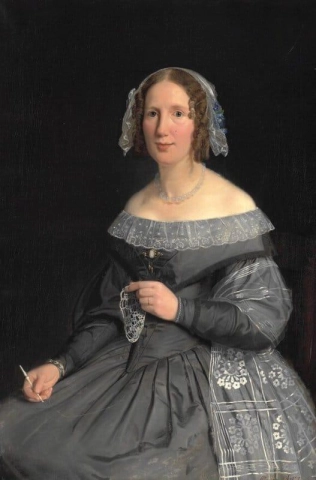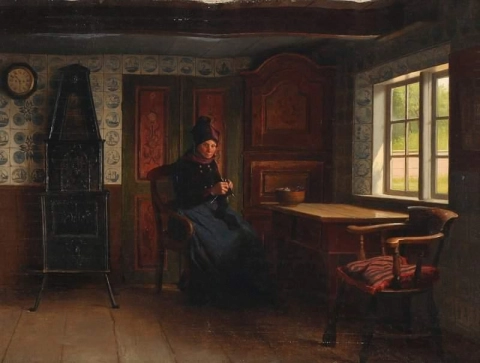

Hand painted reproductions of Julius Exner
Julius Exner: Renowned 19th Century Danish Painter of Portraits and Landscapes
Julius Exner (1825–1904) was a prominent Danish artist, celebrated for his skill in portraiture and landscape painting. His works stand as a testament to the rich artistic heritage of Denmark during the 19th century, capturing the nuances of the Danish countryside as well as the emotions of his subjects with remarkable precision. Exner’s style evolved over the decades, reflecting his strong academic training and a deep appreciation for the natural beauty of his homeland.
Early Life and Education
Born in 1825 in Copenhagen, Denmark, Julius Exner came from an artistically inclined family. His early exposure to the world of art was facilitated by his father, who was a successful painter and engraver. Exner demonstrated his artistic talent from a young age, prompting his family to support his artistic endeavors.
Exner began his formal education at the Royal Danish Academy of Fine Arts, where he studied under the tutelage of leading Danish artists. This education provided him with a strong foundation in classical techniques, and Exner quickly developed a reputation for his discipline and skill. After his studies, he embarked on further travel to expand his knowledge and experience, particularly spending time in Italy, which had a profound influence on his approach to both portraiture and landscapes.
Artistic Development and Style
Julius Exner’s artistic style was deeply rooted in realism, which was the dominant movement in European art during the 19th century. His portraits, known for their lifelike detail and emotional depth, often captured his subjects in moments of contemplation or reflection, offering a window into their inner worlds. Whether painting distinguished members of Danish society or ordinary citizens, Exner's skillful rendering of facial expressions and textures made his portraits compelling and relatable.
Exner was also an accomplished landscape painter, especially noted for his depictions of the Danish countryside. His landscapes often showcase tranquil vistas, rolling hills, and expansive skies, conveying the beauty and serenity of Denmark’s natural environment. His use of light was particularly striking, with an ability to capture the atmospheric qualities of both rural and urban settings.
Though Exner worked within the academic tradition, he gradually began to incorporate elements of Impressionism, particularly in his landscapes. His use of color and light in these works became more expressive over time, capturing the changing moods of nature. This shift in his technique demonstrated his adaptability and keen observational skills, as he sought to reflect both the physical and emotional aspects of the world around him.
Themes and Significance
Exner’s work often revolved around two central themes: the human figure and the landscape. His portraits, rich with emotion and expression, are a window into the social fabric of 19th-century Denmark. They capture individuals from various walks of life, offering an intimate portrayal of their character and status in society. This ability to humanize his subjects set Exner apart as a master portraitist.
In his landscapes, Exner’s focus was on capturing the harmonious relationship between humans and nature. His work reflected a deep connection to the Danish countryside, often portraying rural scenes where people coexisted peacefully with the land. These landscapes are characterized by their tranquility and order, often devoid of human conflict, reflecting the calm and balanced nature of Danish society during the period.
Exner’s art also offers a glimpse into the cultural values of his time. His portraits often convey a sense of dignity, reflecting the respect and reverence for social order that characterized 19th-century Denmark. His landscapes, on the other hand, emphasize the importance of nature in Danish life, underscoring the nation's close connection to the land.
Achievements and Influence
Throughout his career, Julius Exner exhibited his works at prominent exhibitions in Denmark and abroad, earning recognition for his technical proficiency and emotional depth. He was a key figure in the Danish art scene, known for his contributions to both portraiture and landscape painting.
Exner’s influence extended beyond his lifetime. His work inspired a generation of Danish artists, many of whom admired his ability to capture both the physical details and emotional subtleties of his subjects. His landscapes, in particular, helped to establish a tradition of landscape painting in Denmark, one that focused on the peaceful coexistence of humanity and nature.
Though he did not gain the international fame of some of his contemporaries, Exner’s works were highly regarded in Denmark. His ability to portray the Danish landscape with such sensitivity and realism made him an important figure in the development of Danish art during the 19th century.
Legacy
Julius Exner’s legacy as a painter is marked by his exceptional talent in both portrait and landscape painting. His ability to capture the essence of his subjects, both human and natural, left a lasting impact on the Danish art world. His works remain cherished for their technical brilliance, emotional depth, and ability to reflect the Danish way of life during his time.
Today, Exner’s paintings can be found in various museums and private collections, where they are admired for their historical significance and artistic merit. His portraits continue to be valued for their intimate portrayal of Danish society, while his landscapes are celebrated for their depiction of Denmark’s serene and picturesque countryside.
Where to Find Reproductions of Julius Exner’s Art
For those interested in bringing the elegance and charm of Julius Exner’s portraits and landscapes into their homes, POD (Painting On Demand) offers high-quality oil painting reproductions. These reproductions bring the beauty and sophistication of Exner's works into your living space, offering a timeless artistic experience that captures the essence of Denmark's rich heritage.
Imagine owning an original-style painting by one of the greatest artists in history. At POD, we offer you the chance to make this dream a reality. Each canvas is faithfully reproduced down to the smallest detail, allowing you to experience the beauty of the artist’s vision in your own home.
Our reproductions are crafted by experienced painters using the finest materials and time-honored methods. We are committed to delivering works of exceptional quality that will inspire and bring joy to your family for generations to come.




















